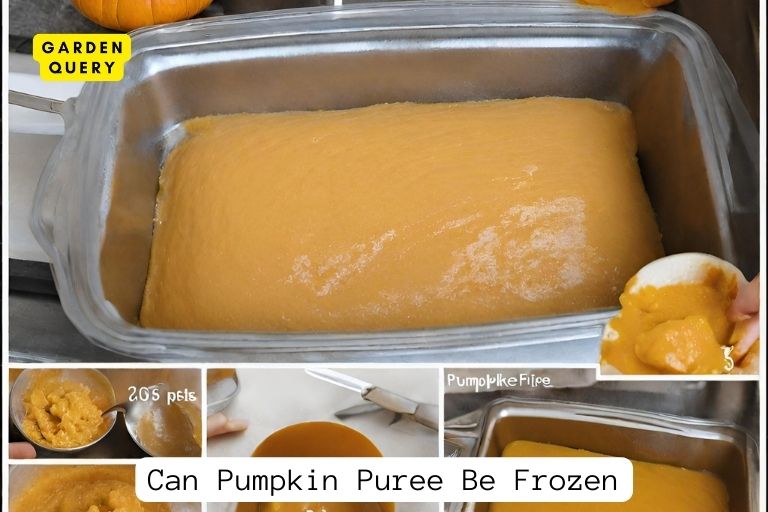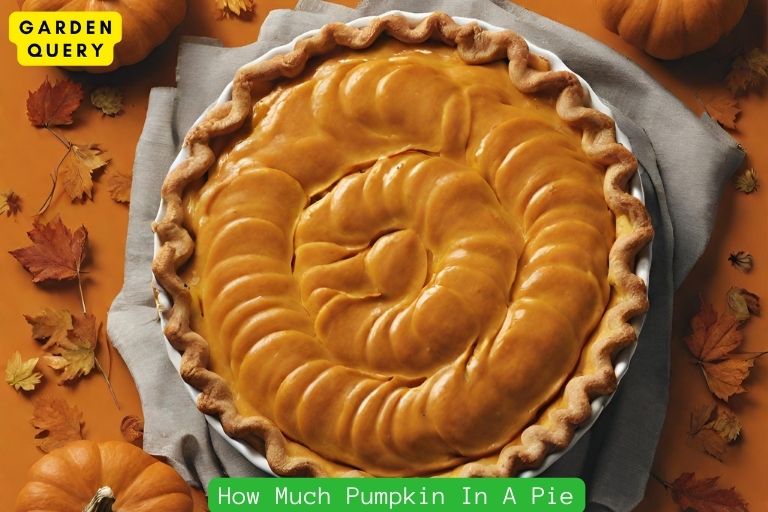Can Pumpkin Puree Be Frozen?
Yes, pumpkin puree can be frozen, providing a convenient way to preserve its freshness and extend its usability.
Freezing pumpkin puree is a practical method for prolonging its shelf life, allowing you to store surplus quantities or prepare in advance for seasonal recipes. To freeze pumpkin puree, it’s crucial to cool it thoroughly, transfer it into airtight containers or freezer bags, and leave sufficient headspace to accommodate expansion during freezing.
Properly stored, frozen pumpkin puree maintains its flavor, color, and nutritional value for an extended period. Thawing frozen puree is best done gradually in the refrigerator, preserving its original texture and taste. Whether used for pies, soups, or smoothies, frozen pumpkin puree offers the convenience of having this versatile ingredient readily available.
Key Takeaway
Can Pumpkin Puree Be Frozen
What is pumpkin puree and its uses
Pumpkin puree is a versatile ingredient made by cooking and pureeing pumpkin flesh. It is commonly used in various sweet and savory recipes, including pumpkin pies, soups, muffins, and bread. The smooth and creamy texture adds richness and depth to dishes, making it a favorite during the autumn season.

Benefits of freezing pumpkin puree
Freezing pumpkin puree can be a convenient option for preserving leftovers or surplus pumpkins. Here are some benefits of freezing pumpkin puree:
- Longer shelf life: Freezing allows you to extend the shelf life of pumpkin puree. When properly stored, frozen pumpkin puree can last up to 3 to 6 months, maintaining its flavor and quality.
- Convenience: By freezing pumpkin puree, you can have an instant stash of this ingredient readily available whenever you need it. It eliminates the need for repeated cooking and pureeing fresh pumpkins, saving you time and effort.
- Reduce food waste: If you have excess pumpkin puree that you won’t be able to consume immediately, freezing is a great way to minimize food waste. Instead of letting it spoil, freezing allows you to preserve the puree for future use.
- Year-round availability: Freezing pumpkin puree enables you to enjoy the taste of pumpkin all year round, even when fresh pumpkins are out of season. You can stock up on pumpkins during the fall, make puree, and freeze it for later use.
When freezing pumpkin puree, ensure proper storage to maintain its quality:
- Use a freezer-safe container: Transfer the pumpkin puree into airtight, freezer-safe containers or resealable freezer bags. Remove any excess air to prevent freezer burn.
- Label and date: Clearly label the containers or bags with the date of freezing. This helps you keep track of the freshness of the puree.
- Portion control: Consider freezing the pumpkin puree in smaller portions. This way, you can thaw only the amount needed for a specific recipe, minimizing waste.
- Thawing and using frozen pumpkin puree: To thaw frozen pumpkin puree, transfer it to the refrigerator and allow it to defrost overnight. Alternatively, you can thaw it in the microwave on a low power setting. Once thawed, the pumpkin puree can be used in your favorite recipes as you would use fresh puree.
It is important to note that freezing may slightly affect the texture of the pumpkin puree. Sometimes, the thawed puree can become slightly watery or grainy. However, this shouldn’t significantly impact its taste or usability in most recipes.
In conclusion, yes, pumpkin puree can be frozen. Freezing pumpkin puree allows for longer shelf life, convenience, and reduced food waste. By following proper storage techniques, you can enjoy the taste of pumpkin year-round and have a readily available supply of this versatile ingredient.
Freezing Pumpkin Puree
Freezing pumpkin puree is a convenient way to preserve the delicious taste and nutritional benefits of this fall favorite. Whether you have a surplus of fresh pumpkin or want to save time by making large batches of puree, freezing is a simple and effective method. Let’s explore the different methods of freezing pumpkin puree and some helpful tips for preparing it.
Methods of freezing pumpkin puree
There are a few ways to freeze pumpkin puree, depending on your preferences and available resources:
- Ice cube trays: This method allows you to freeze small portions of pumpkin puree for easy thawing and portion control. Simply scoop the puree into ice cube trays and freeze until solid. Once frozen, transfer the cubes into a freezer bag or airtight container for long-term storage.
- Freezer bags or containers: For larger quantities of pumpkin puree, use freezer-safe bags or containers. Portion the puree into smaller sizes, leaving some headspace for expansion during freezing. Squeeze out excess air and seal the bags tightly, or cover the containers with an airtight lid. Label them with the date and quantity for easier identification.
- Parchment paper: If you prefer a thinner layer of pumpkin puree, spread it onto parchment paper in a baking sheet. Place the sheet in the freezer until the puree is solid. Once frozen, cut it into portions or break it into smaller pieces for easier storage in freezer bags or containers.
Tips for preparing pumpkin puree for freezing
To ensure the best quality of frozen pumpkin puree, follow these helpful tips:
- Selecting and preparing the pumpkin: Choose a pumpkin variety specifically for cooking, such as a sugar pumpkin or pie pumpkin. Remove the stem, cut the pumpkin in half, and scoop out the seeds and stringy pulp. Roasting the pumpkin halves in the oven at 350°F (175°C) until fork-tender is a popular method, but steaming or boiling are also options.
- Straining excess liquid: After cooking the pumpkin, allow it to cool and then drain any excess liquid. This step prevents the puree from becoming watery during freezing.
- Pureeing the pumpkin: Once drained, puree the pumpkin in a food processor or blender until smooth. If the puree is too thick, you can add a little water or vegetable broth to achieve the desired consistency.
- Portioning and labeling: Divide the pumpkin puree into appropriate portions based on your needs. Consider the recipes you’ll be using and portion accordingly. Label the storage bags or containers with the date and quantity for easy reference in the future.
- Freezing and thawing: Place the sealed bags or containers in the freezer, ensuring they are arranged flat for efficient freezing and easy storage. When ready to use the frozen pumpkin puree, simply thaw it in the refrigerator overnight or defrost it in the microwave using the defrost setting.
Freezing pumpkin puree is a great way to enjoy the flavors of autumn all year round. With these methods and tips, you can confidently freeze your surplus pumpkin puree and have it ready for your favorite recipes whenever you want. So, don’t let that pumpkin go to waste – freeze it
Storing and Thawing Pumpkin Puree
For pumpkin enthusiasts and home cooks, the fall season means one thing – pumpkin everything! From pumpkin pie to pumpkin bread, there’s no shortage of delicious recipes that call for pumpkin puree. But what happens if you have an abundance of pumpkin puree and you’re wondering if it can be frozen for later use? The answer is yes, pumpkin puree can be frozen, allowing you to enjoy that quintessential fall flavor all year round.
Proper storage of frozen pumpkin puree
When it comes to freezing pumpkin puree, proper storage is key to maintaining its quality. Here are a few steps to follow:
- Start with fresh puree: Make sure you have freshly made pumpkin puree that has been properly cooked and blended. Homemade puree is best, as it usually contains no additives or preservatives.
- Choose the right container: Opt for airtight containers or freezer bags that are specifically designed for freezing. These containers help prevent freezer burn and keep out any unwanted odors.
- Portion sizes: Consider freezing the puree in smaller portion sizes to make it easier to thaw and use. This way, you can thaw only what you need, rather than having to thaw and refreeze the entire batch.
- Label and date: Don’t forget to label each container or bag with the date of freezing. This will help you keep track of how long the puree has been stored and ensure that you use the oldest puree first.
- Freezer placement: Store the containers or bags in the freezer, making sure to place them in a way that allows for efficient freezing and easy stacking.
Thawing frozen pumpkin puree
When it’s time to use your frozen pumpkin puree, there are a few methods you can follow to thaw it properly:
- Refrigerator thawing: The most recommended method is to thaw the puree in the refrigerator. Simply transfer the frozen container or bag to the refrigerator and allow it to thaw slowly overnight or for a few hours. This slow thawing process helps maintain the texture and flavor of the puree.
- Cold water thawing: If you’re short on time, you can thaw the pumpkin puree in cold water. Place the frozen container or bag in a bowl of cold water, making sure it is completely submerged. Change the water every 30 minutes to speed up the thawing process. Remember to use the puree immediately after it has thawed.
- Microwave thawing: If you’re in a hurry, you can use the microwave to thaw the pumpkin puree. Transfer the frozen puree to a microwave-safe bowl and heat it in short intervals, stirring occasionally to ensure even thawing. Be careful not to cook the puree; you only want to thaw it.
Now that you know how to store and thaw pumpkin puree, you can keep that warm, comforting flavor handy all year round. Whether you’re craving a slice of pumpkin pie or a batch of pumpkin pancakes, having frozen pumpkin puree on hand makes it easy to satisfy your fall cravings whenever they strike. So go ahead, stock up on pumpkin puree and embrace the flavors of autumn!
Benefits and Considerations
Advantages of freezing pumpkin puree
Freezing pumpkin puree can be a convenient way to preserve the flavor and nutritional benefits of this versatile ingredient. Here are a few advantages of freezing pumpkin puree:
- Extended shelf life: Freezing pumpkin puree can significantly extend its shelf life compared to refrigeration or keeping it at room temperature. This allows you to enjoy the taste of pumpkin all year round.
- Convenience: By freezing pumpkin puree, you can have it readily available whenever you need it. This can save you time and effort, especially during busy seasons or when pumpkin is not in season.
- Flexible portioning: When you freeze pumpkin puree, you can portion it according to your needs. You can freeze small quantities in ice cube trays for use in recipes that require a small amount of pumpkin, or freeze larger portions for making pies and other dishes.
- Cost-effective: If you come across a sale or have an abundance of fresh pumpkin, freezing the puree can help you save money. You can buy or harvest a larger quantity of pumpkin, puree it, and freeze it for later use instead of purchasing canned pumpkin.
Potential issues with frozen pumpkin puree
While freezing pumpkin puree is convenient, there are a few considerations to keep in mind:
- Texture changes: Freezing can cause changes in texture, and pumpkin puree may become slightly watery or grainy after thawing. However, these texture changes are generally minor and do not affect the taste or usability of the puree in most recipes.
- Storage space: Before freezing pumpkin puree, make sure you have enough freezer space to accommodate it. Consider using freezer-safe bags or containers that are properly labeled and sealed to prevent freezer burn.
- Thawing and refreezing: It is best to thaw frozen pumpkin puree in the refrigerator overnight or defrost it in the microwave using the defrost setting. Avoid refreezing thawed pumpkin puree as it can lead to a decline in quality and potential food safety issues.
- Recipe compatibility: While frozen pumpkin puree can be used in many recipes, some recipes may require fresh pumpkin for optimal results. Recipes that rely on the texture or moisture content of fresh pumpkin may not yield the same results with frozen puree.
In conclusion, freezing pumpkin puree can be a convenient way to preserve this seasonal ingredient. The benefits of extended shelf life, convenience, flexible portioning, and cost-effectiveness make it an attractive option for many home cooks and bakers. Just be aware of potential texture changes, storage considerations, and recipe compatibility when using frozen pumpkin puree
- Best Therapists In Dallas - February 1, 2024
- Holly Willoughby Husband: Holly Willoughby’s Love Story - January 30, 2024
- Holly Willoughby Dress: 5 Style Secrets and 7 Must-Know Career Milestones - January 30, 2024





